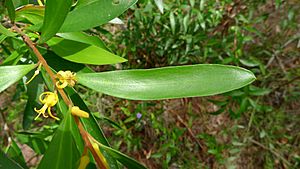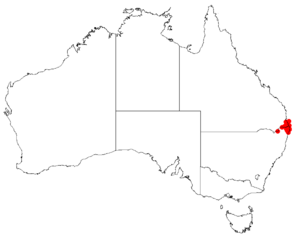Persoonia adenantha facts for kids
Quick facts for kids Persoonia adenantha |
|
|---|---|
 |
|
| In the Koonyum Range near Mullumbimby | |
| Scientific classification | |
| Genus: |
Persoonia
|
| Species: |
adenantha
|
 |
|
| Occurrence data from Australasian Virtual Herbarium | |
The Persoonia adenantha is a special plant that belongs to the plant family called Proteaceae. You can only find it growing naturally in eastern Australia. It's usually a tall shrub or a small tree with smooth, oval-shaped leaves and groups of fuzzy yellow flowers. Sometimes, people have mixed it up with other similar plants like P. cornifolia and P. stradbrokensis.
What Does It Look Like?
Persoonia adenantha is a plant that stands upright. It can be a shrub or a small tree. It grows to be about 2.5 to 9 meters (8 to 30 feet) tall. Its younger branches are covered in soft hairs. Older parts of the plant have smooth bark.
The leaves are flat and shaped like a narrow oval or a spear. Their edges are usually turned down a bit. These leaves are 30 to 140 millimeters (1 to 6 inches) long. They are also 6 to 30 millimeters (0.2 to 1 inch) wide. When they are young, the leaves are hairy. But as they get older, they become smooth.
The flowers are bright yellow. They grow in groups. Each flower has a straight, hairy stalk, which is called a pedicel. These stalks are about 1 to 4 millimeters (0.04 to 0.16 inches) long. Each flower has four parts, called tepals. These tepals are 10 to 13 millimeters (0.4 to 0.5 inches) long. They are joined together at the bottom. Their tips curl back. Each tepal has a clear, pointed end.
In the middle of the flower, there is a central part called a style. Around this style are four yellow parts that hold pollen, called anthers. These anthers are also joined at their base. Their tips curl back, making the flower look like a cross when you look at it from the end.
This plant blooms from November to April. After the flowers, it grows green fruits. These fruits are called drupes. A drupe is a fleshy fruit with a hard pit or seed inside, like a peach.
How Did It Get Its Name?
The plant Persoonia adenantha was first officially described in 1921. A Czech scientist named Karel Domin gave it its formal description. He found a sample of the plant in a forest near the Logan River. His description was then published in a science journal called Bibliotheca Botanica.
The second part of the plant's scientific name, adenantha, comes from Ancient Greek words. The word aden means "gland."
Where Does It Grow?
This type of persoonia plant grows in different places. You can find it in open areas with low shrubs (called heath). It also grows in forests and in rainforests.
Its natural home is between Pimpama and Tamborine Mountain in south-east Queensland. It also grows south of there, all the way to Evans Head in New South Wales.
Growing This Plant
Persoonia adenantha could be a great plant for gardens. You can use it to make a neat, trimmed hedge or a more natural-looking one. If you want to grow these plants in your garden, they need soil that drains water well. This means the water should not sit around the plant's roots.

